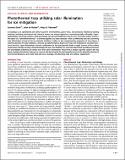| dc.contributor.author | Dash, Susmita | |
| dc.contributor.author | de Ruiter, Jolet | |
| dc.contributor.author | Varanasi, Kripa | |
| dc.date.accessioned | 2019-02-19T18:46:01Z | |
| dc.date.available | 2019-02-19T18:46:01Z | |
| dc.date.issued | 2018-08 | |
| dc.identifier.issn | 2375-2548 | |
| dc.identifier.uri | http://hdl.handle.net/1721.1/120491 | |
| dc.description.abstract | Ice buildup is an operational and safety hazard in wind turbines, power lines, and airplanes. Traditional deicing methods, including mechanical and chemical means, are energy-intensive or environmentally unfriendly. Super-hydrophobic anti-icing surfaces, while promising, can become ineffective due to frost formation within textures. We report on a “photothermal trap”—a laminate applied to a base substrate—that can efficiently deice by converting solar illumination to heat at the ice-substrate interface. It relies on the complementing properties of three layers: a selective absorber for solar radiation, a thermal spreader for lateral dispersal of heat, and insulation to minimize transverse heat loss. Upon illumination, thermal confinement at the heat spreader leads to rapid increase of the surface temperature, thereby forming a thin lubricating melt layer that facilitates ice removal. Lateral heat spreading overcomes the unavoidable shadowing of certain areas from direct illumination. We provide a design map that captures the key physics guiding illumination-induced ice removal. We demonstrate the deicing performance of the photothermal trap at very low temperatures, and under frost and snow coverage, via laboratory-scale and outdoor experiments. | en_US |
| dc.description.sponsorship | ALSTOM (Firm) | en_US |
| dc.description.sponsorship | Netherlands Organization for Scientific Research (NWO) (Rubicon Fellowship) | en_US |
| dc.publisher | American Association for the Advancement of Science (AAAS) | en_US |
| dc.relation.isversionof | http://dx.doi.org/10.1126/sciadv.aat0127 | en_US |
| dc.rights | Creative Commons Attribution NonCommercial License 4.0 | en_US |
| dc.rights.uri | https://creativecommons.org/licenses/by-nc/4.0/ | en_US |
| dc.source | Science Advances | en_US |
| dc.title | Photothermal trap utilizing solar illumination for ice mitigation | en_US |
| dc.type | Article | en_US |
| dc.identifier.citation | Dash, Susmita, Jolet de Ruiter, and Kripa K. Varanasi. “Photothermal Trap Utilizing Solar Illumination for Ice Mitigation.” Science Advances 4, no. 8 (August 2018): eaat0127. © 2018 The Authors | en_US |
| dc.contributor.department | Massachusetts Institute of Technology. Department of Mechanical Engineering | en_US |
| dc.contributor.mitauthor | Dash, Susmita | |
| dc.contributor.mitauthor | de Ruiter, Jolet | |
| dc.contributor.mitauthor | Varanasi, Kripa | |
| dc.relation.journal | Science Advances | en_US |
| dc.eprint.version | Final published version | en_US |
| dc.type.uri | http://purl.org/eprint/type/JournalArticle | en_US |
| eprint.status | http://purl.org/eprint/status/PeerReviewed | en_US |
| dc.date.updated | 2019-02-15T14:50:40Z | |
| dspace.orderedauthors | Dash, Susmita; de Ruiter, Jolet; Varanasi, Kripa K. | en_US |
| dspace.embargo.terms | N | en_US |
| dc.identifier.orcid | https://orcid.org/0000-0003-0952-4209 | |
| dc.identifier.orcid | https://orcid.org/0000-0001-5411-4132 | |
| dc.identifier.orcid | https://orcid.org/0000-0002-6846-152X | |
| mit.license | PUBLISHER_CC | en_US |
